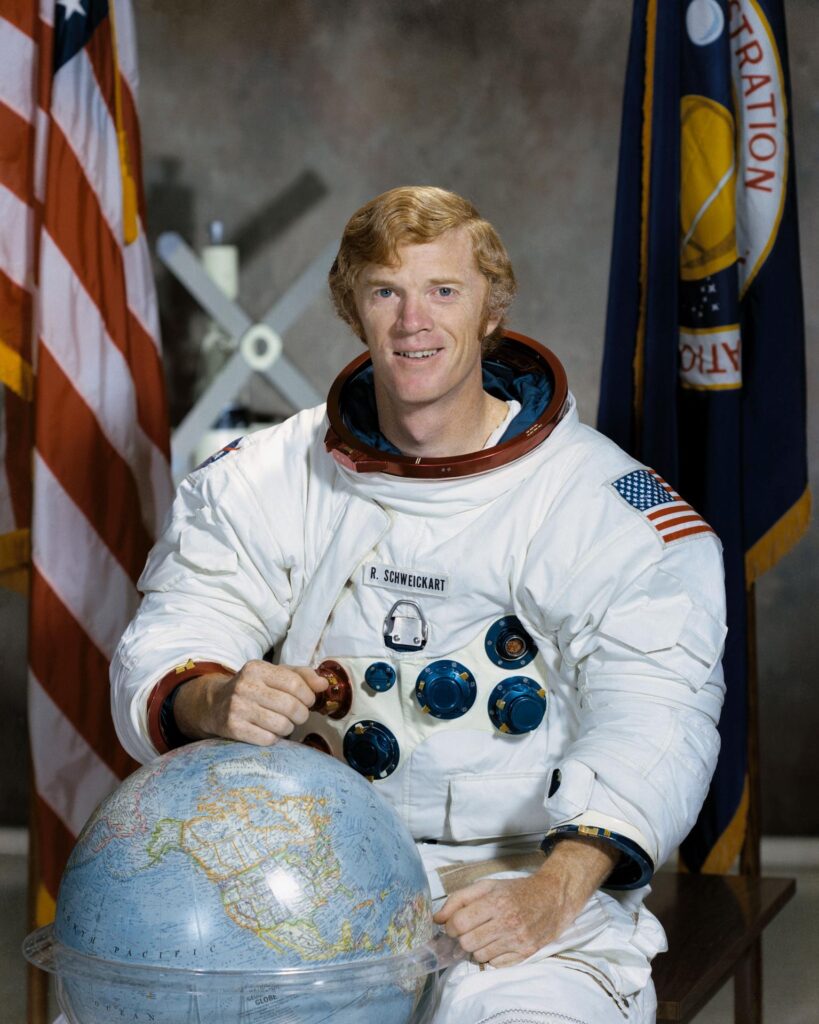Lunar Module Pilot on Apollo 9 mission.
Born on October 25, 1935, in Neptune, New Jersey, Schweickart graduated from Manasquan High School in Belmar, New Jersey. He received a Bachelor of Science degree in 1956, and a Master of Science degree in 1963, both from the Massachusetts Institute of Technology (MIT). He also served as a pilot in the U.S. Air Force and Massachusetts Air National Guard from 1956 to 1963, reaching the rank of Captain and logging 4,200 hours of flight time, 3,500 in jet aircraft. During this period he was a research scientist in the Experimental Astronomy Laboratory at MIT. His work there involved research in upper atmospheric physics, star tracking, and stabilization of stellar images.
In October 1963, Captain Schweickart was one of the fourteen men in the third group of astronauts selected by NASA. He was chosen to plan in-flight experiments and future science programs. From March 3 to 13, 1969, he was the Lunar Module pilot on the Apollo 9 mission, the first to test the Moon-landing vehicle in space. After reaching Earth orbit Spacecraft Commander James McDivitt and Schweickart tested every system in the still-attached vehicle for two days then separated it from the Command Module and flying it 113 miles away. After executing a series of maneuvers, they returned for a successful docking with the Command Module, manned by Command Module pilot David Scott.
Schweickart began to suffer from space sickness on the first day in orbit forcing the postponement of a planned extravehicular activity (EVA). Eventually, his condition improved and he completed an EVA standing on the lunar module. Schweickart’s 46-minute spacewalk also tested the portable life support backpack that astronauts would use later on the Moon. The space sickness contributed to Captain Schweickart being sidelined for further Apollo missions so he concentrated on the Skylab program. During his one flight, he logged 10.04 days in space.
In 1973, Schweickart was assigned as part of the backup crew for Skylab-2. That same year he played a major role in directing the repair of the Skylab space station from the ground. On May 1, 1974, Captain Schweickart left the Astronaut Office at Johnson Space Center for NASA Headquarters in Washington, D.C. as Director of User Affairs in the Office of Applications. He helped various governmental and industrial organizations to facilitate the practical application of space technology in fields such as communications, meteorology, earth resources, and space processing. Schweickart then held several technology-related positions with the California state government, including Assistant to the Governor for Science and Technology. He left NASA on July 1, 1979, to be Chairman of the California Energy Commission.
From 1987 to 1988, Captain Schweickart chaired the United States Antarctic Program Safety Review Panel for the Director of the National Science Foundation (NSF) in Washington, DC. He helped to produce a report, Safety in Antarctica, that was a comprehensive on-site review of all U.S. activities in Antarctica, led to a restructuring of the program, increasing the safety of operations in the hazardous environment of Antarctica.
Schweickart was next to the Executive Vice President of CTA Commercial Systems, Inc. and Director of Low Earth Orbit (LEO) Systems. Schweickart led CTA’s efforts in developing the GEMnet system, a second generation LEO communication satellite constellation designed to provide regular commercial electronic messaging services on a global basis. Prior to his CTA work, Schweickart founded and was president of Courier Satellite Services, Inc., a global satellite communications company which developed LEO satellites to provide worldwide affordable data services.
Rusty Schweickart is the founder and past president of the Association of Space Explorers (ASE), the international professional society of astronauts and cosmonauts. The organization promotes the cooperative exploration and development of space and the use of space technology for human benefit. The ASE has a current membership of over 300 astronauts and cosmonauts from 29 nations. The Association’s first book, The Home Planet, with a preface by Schweickart, was published in 1988 and was an immediate international bestseller.
Captain Schweickart helped develop international communications regulations and policies and participated in the 1992 and 1995 World Radio-communications Conferences of the International Telecommunications Union. He also worked extensively in Russia and the former USSR on scientific and telecommunications matters. Later Schweickart was president of Aloha Networks, until 1998.
At the request of the National Science Foundation, Schweickart served on the 1997-1998 United States Antarctic Program Outside Review Panel, which reported to the Whitehouse and Congress on the future of U.S. facilities in Antarctica. America’s Amundson-Scott South Pole station has been fully rebuilt as a result of this work.
Among his honors and awards are the NASA Distinguished Service Medal (1969) and the Federation Aéronautique Internationale De La Vaux Medal (1970) for his Apollo 9 flight. He also received the National Academy of Television Arts and Sciences Special Trustees Award (Emmy) in 1969 for transmitting the first live TV pictures from space. In 1973, Schweickart was awarded the NASA Exceptional Service Medal for his leadership in the Skylab rescue efforts.

